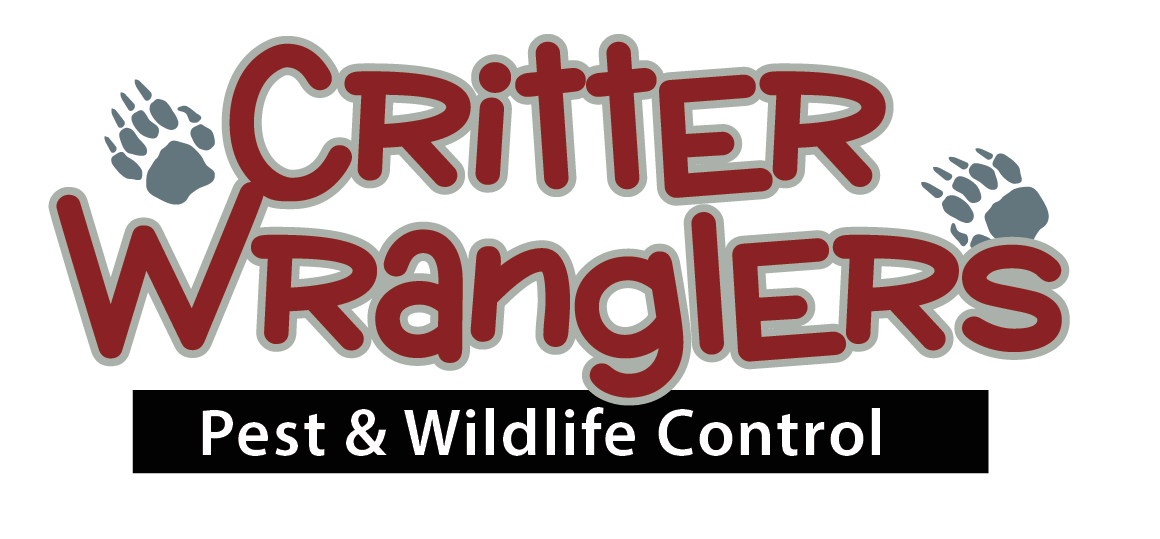Critter Wranglers, LLC Blog
Have an issue? Contact us today
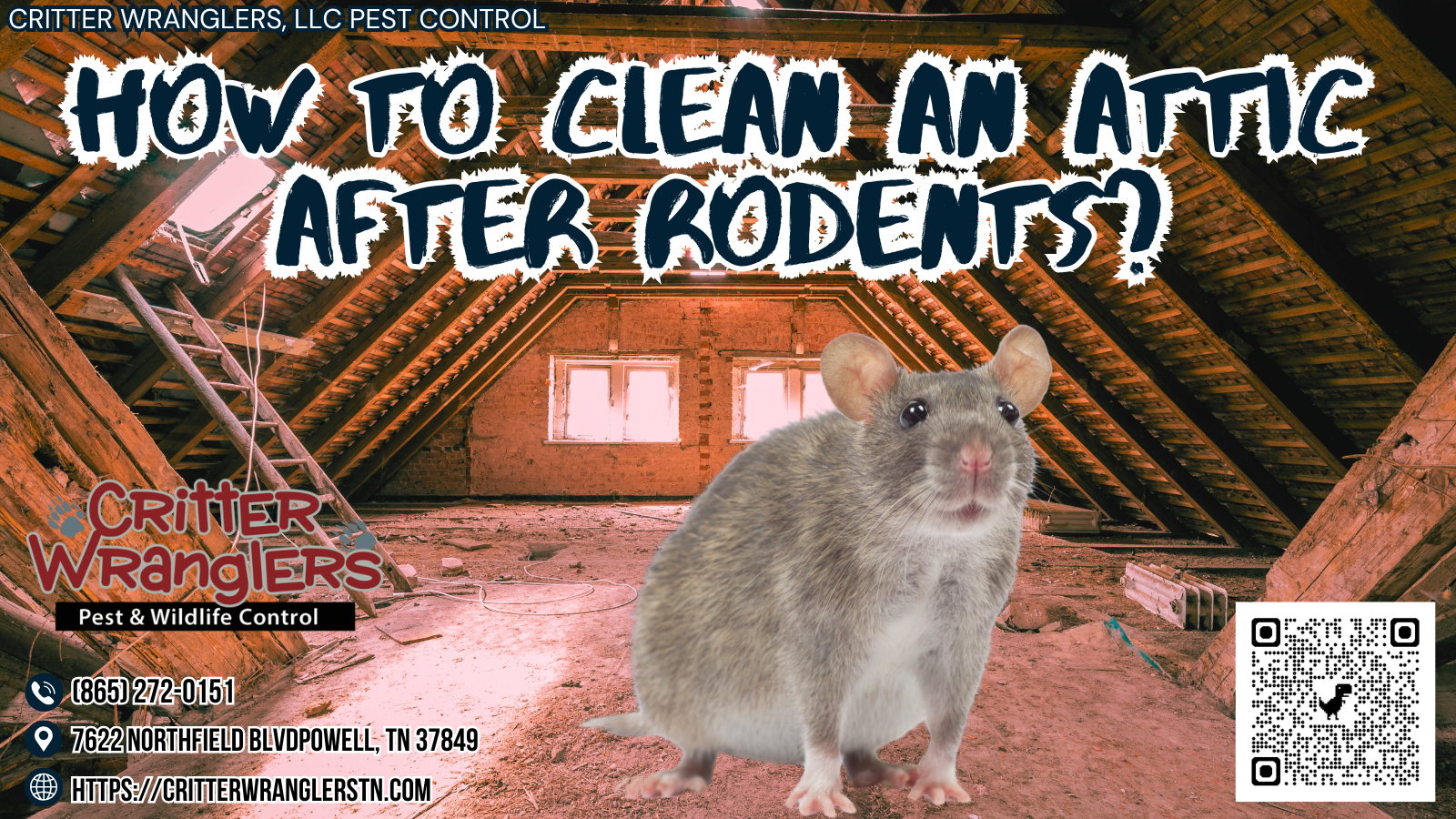
How to Clean an Attic After Rodents?
To clean an attic after rodents, start by evaluating the infestation. Identify signs like droppings and nests. Gather supplies such as trash bags, gloves, masks, and disinfectants. Wear protective gear to avoid contact with contaminants. Remove and properly dispose of contaminated items, sealing them in labeled bags. Clean surfaces with disinfectants and guarantee good ventilation. Seal any entry points to prevent future infestations, checking gaps around pipes and vents. Regularly inspect the area and maintain cleanliness to deter rodents. This structured approach guarantees a safer and cleaner attic environment while protecting your home from future pests. Additional details can enhance your understanding further.
Key Article Highlights
- Assess the infestation by inspecting for droppings, nests, and signs of damage to prioritize cleaning areas.
- Wear protective gear, including gloves and masks, to ensure safety while handling contaminated materials.
- Remove and dispose of contaminated items in heavy-duty trash bags, sealing and labeling them appropriately.
- Clean and disinfect surfaces with appropriate cleaning supplies, allowing disinfectants to sit as instructed for maximum effectiveness.
- Seal entry points to prevent future infestations, using materials like steel wool and caulk to block gaps.
Assess the Infestation
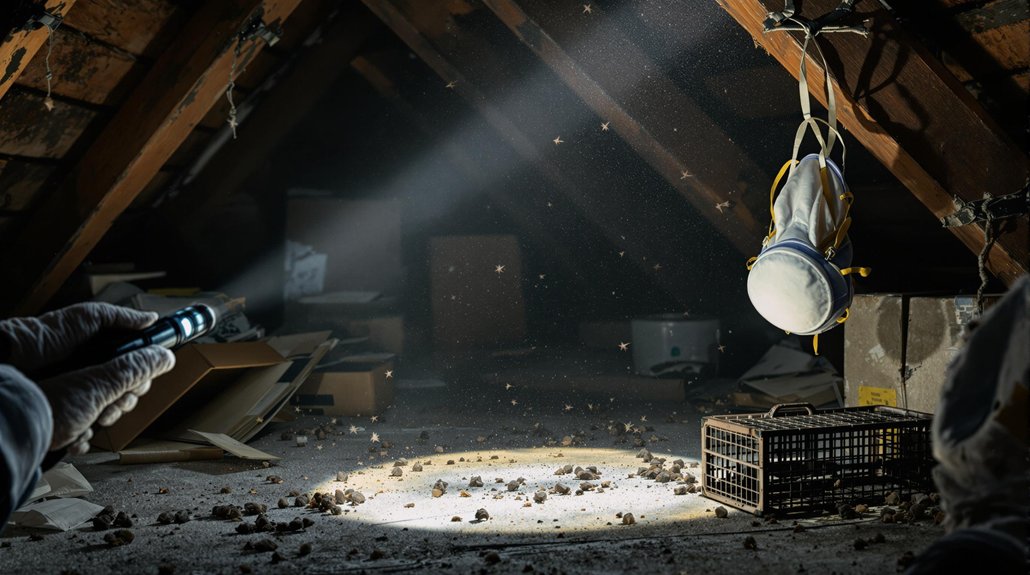
Before initiating the cleaning process, it is essential to assess the infestation thoroughly to understand the extent of the problem. Begin by looking for infestation signs, such as droppings, gnawed materials, and nesting areas. These indicators reveal where rodents have been active. Pay close attention to the specific rodent behavior, as different species may leave distinct marks or damage. For example, mice tend to create small nests, while rats may leave larger droppings. Observing these behaviors can help you determine how severe the infestation is and what areas require more attention. Understanding the presence and activity of rodents will inform your cleaning strategy and guarantee that all affected spaces are addressed effectively for a safe environment.
Gather Necessary Supplies
Before starting the cleaning process, it is important to gather the necessary supplies. You will need specific cleaning tools, such as brooms and disinfectants, as well as protective gear like gloves and masks. Having the right equipment guarantees a safe and effective cleaning experience.
Cleaning Tools Required
A variety of essential cleaning tools are necessary to effectively address the aftermath of a rodent infestation in your attic. Proper cleaning equipment and sanitation products will help guarantee a thorough and safe cleanup process. Here's a list of key items to gather:
- Heavy-duty trash bags – For disposing of contaminated materials.
- Broom and dustpan – To collect debris and droppings easily.
- Vacuum cleaner with a HEPA filter – For trapping fine particles and allergens.
- Disinfectant sprays or wipes – To sanitize surfaces and eliminate harmful bacteria.
Having these tools on hand will facilitate the cleaning process and help restore your attic to a safe and healthy environment.
Protective Gear Essentials
Securing your safety during the cleanup process is vital, as rodent infestations can pose health risks. To protect yourself, gather necessary protective gear before starting. First, wear protective gloves to prevent direct contact with droppings, urine, or nesting materials. This will help shield your skin from harmful pathogens. Next, safety goggles are important to guard your eyes from dust and debris that may be disturbed during cleaning. Additionally, consider wearing a mask to avoid inhaling any airborne particles. Having a long-sleeved shirt and sturdy boots can further enhance your safety. By equipping yourself with these protective items, you not only safeguard your health but also facilitate a more effective cleanup process, allowing you to serve others with confidence.
Wear Protective Gear
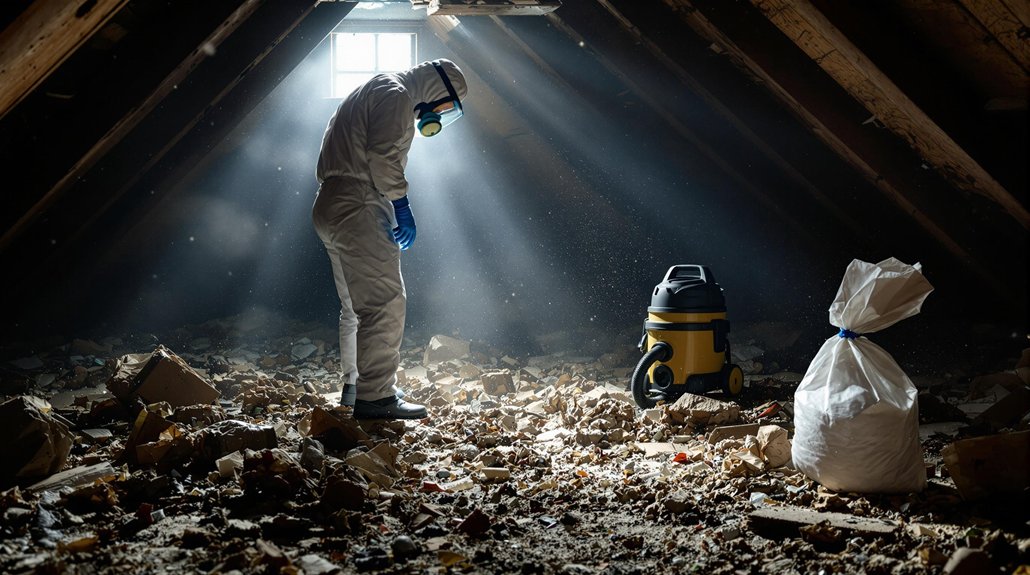
When cleaning an attic after rodent activity, wearing protective gear is vital for your safety. Essential protective equipment includes gloves, goggles, and masks, which help shield you from harmful droppings and other contaminants. Additionally, choosing proper clothing can prevent direct contact with any hazardous materials present in the attic.
Essential Protective Equipment
Cleaning an attic after a rodent infestation requires careful preparation, particularly regarding personal safety. To effectively protect yourself during this process, consider the following essential protective equipment:
- Protective Masks: These help filter out harmful dust and allergens.
- Safety Goggles: Protect your eyes from debris and potential contaminants.
- Gloves: Use durable gloves to prevent direct contact with droppings or nesting materials.
- Heavy-Duty Trash Bags: These are necessary for safely disposing of contaminated materials.
Proper Clothing Choices
Choosing the right clothing is essential for safely cleaning an attic after a rodent infestation. Begin with durable, protective clothing materials, such as long-sleeved shirts and pants made of thick fabric. This will shield your skin from sharp objects and potential contaminants. It is also wise to wear gloves to protect your hands from any harmful substances.
Consider the weather when selecting your attire. If the attic is hot, lightweight and breathable materials are ideal to keep you comfortable. Conversely, if it's cold, layering is key to maintaining warmth. Finally, closed-toe shoes with thick soles will provide added protection and grip on uneven surfaces. Proper clothing choices can help guarantee a safer, more effective cleaning process.
Respiratory Protection Importance
Guaranteeing respiratory protection is essential during the process of cleaning an attic after a rodent infestation. The presence of droppings, urine, and nesting materials can pose significant respiratory hazards. To safeguard yourself, consider the following:
- Wear protective masks to filter harmful particles.
- Use N95 respirators or higher-rated masks for better protection.
- Guarantee good ventilation in the attic space to reduce airborne contaminants.
- Avoid stirring up dust which can release hidden pathogens.
Remove Contaminated Items
Begin by carefully evaluating the attic for any contaminated items that may pose health risks due to rodent droppings or nesting materials. Look for insulation, cardboard boxes, or fabrics that have been affected. It is crucial to remove contaminated items promptly to prevent further contamination and protect your health. Use gloves and a mask while handling these materials to guarantee safety. Place the items in heavy-duty trash bags for safe disposal. Seal the bags tightly and label them as contaminated waste. Dispose of them following local regulations to guarantee proper handling of hazardous materials. By taking these steps, you help create a safer environment for yourself and others, fostering a healthier living space.
Clean and Disinfect Surfaces
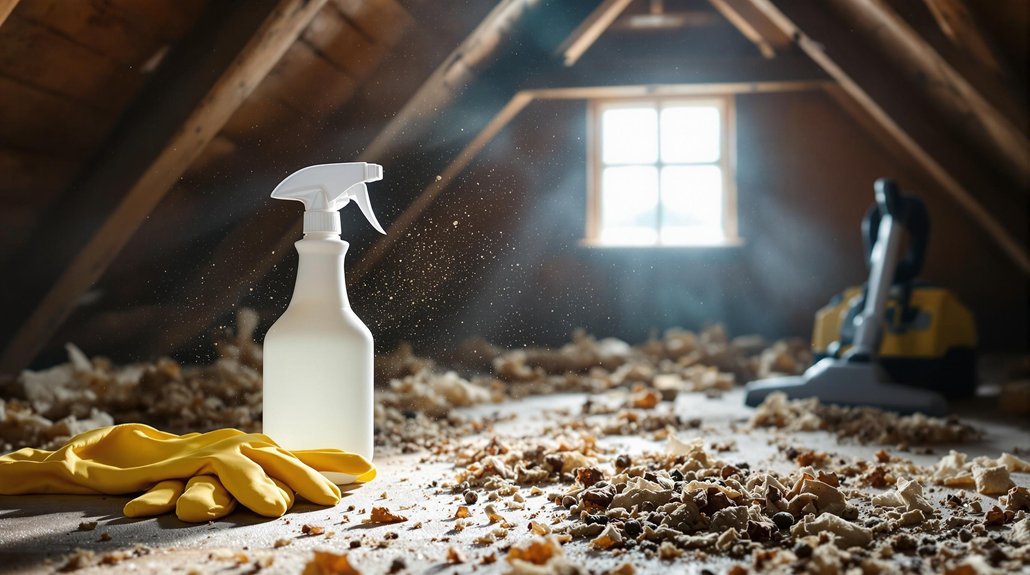
After removing contaminated items, the next step is to clean and disinfect surfaces in the attic. Begin by gathering the necessary cleaning supplies, including disinfectants, gloves, and masks. Understanding the proper disinfecting techniques is essential to guarantee a safe and thorough cleaning process.
Gather Cleaning Supplies
Start by gathering the necessary cleaning supplies to effectively clean and disinfect surfaces in your attic. Having the right tools will make your process smoother and more efficient. Here are some essential items to take into account:
- Heavy-duty gloves – Protect your hands from contaminants.
- Face mask – Avoid inhaling dust and allergens.
- Broom and dustpan – Clear away debris and droppings.
- Disinfectant spray – Verify surfaces are properly sanitized.
Utilizing these cleaning methods along with organization tips will help you maintain a safe environment. By preparing adequately, you can approach the task with confidence, knowing you have the right supplies to serve others by creating a clean, healthy space.
Disinfecting Techniques Explained
Once you have gathered your cleaning supplies, it's time to focus on effective disinfecting techniques. Utilize appropriate disinfecting agents to eliminate harmful bacteria and viruses. Common choices include bleach solutions and commercial disinfectants. Always follow the manufacturer's instructions to guarantee proper sanitation methods.
Here's a simple table to guide you through the process:
| Step | Action | Emotion Evoked |
|---|---|---|
| Gather Supplies | Collect cleaning agents | Preparedness |
| Apply Disinfectant | Use on affected surfaces | Assurance |
| Let Sit | Allow for recommended time | Trust in effectiveness |
| Wipe Clean | Remove residues | Satisfaction |
| Ventilate | Air out the space | Relief |
Following these steps not only protects your space but also fosters a healthier environment for everyone.
Inspect Insulation and Wiring
Inspecting insulation and wiring is an essential step in guaranteeing the safety and integrity of your attic after a rodent infestation. Here's what to look for during your inspection:
- Check for insulation damage: Rodents may create nests or tunnels, compromising insulation efficiency.
- Examine wiring hazards: Look for chewed or frayed wires, which can pose fire risks.
- Assess moisture: Rodents can introduce moisture, leading to mold growth in insulation.
- Evaluate air flow: Guarantee insulation is evenly distributed to maintain proper ventilation.
Addressing these issues promptly can prevent further damage and guarantee a safe environment. If you find significant damage, consider consulting a professional to help restore your attic's safety and functionality.
Seal Entry Points
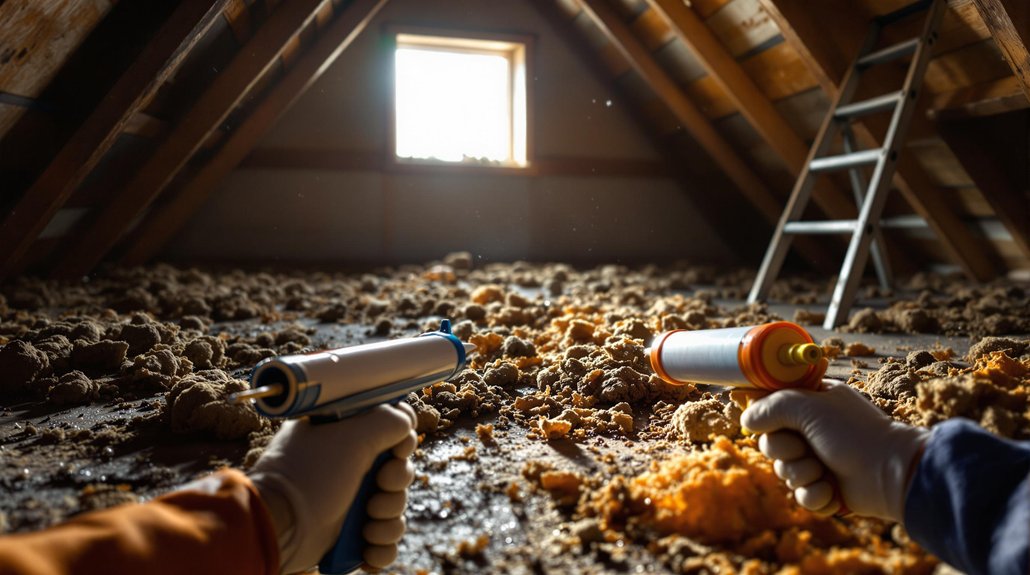
After ensuring that insulation and wiring are in good condition, attention must turn to sealing entry points to prevent future rodent infestations. Identifying potential rodent entry areas is important. Common entry points include gaps around pipes, vents, and windows. Once these areas are located, effective sealing methods should be employed. Use steel wool to fill small holes, as it is resistant to chewing. For larger openings, consider using caulk or expanding foam to create a sturdy barrier. Additionally, installing door sweeps and mesh screens can further deter rodent entry. Regularly inspecting these seals is necessary to maintain their effectiveness. By taking these proactive steps, you can create a safer environment and help others by sharing this significant knowledge.
Prevent Future Infestations
To effectively prevent future infestations, it is essential to adopt a thorough approach that combines cleanliness, monitoring, and proactive measures. Implementing the following preventative measures can greatly reduce the risk of rodents returning:
- Regularly inspect your attic for any signs of rodent activity.
- Maintain cleanliness by removing clutter and food sources that attract pests.
- Utilize natural repellents, such as peppermint oil or vinegar, to deter rodents.
- Install traps strategically to monitor and manage any potential intruders.
Dispose of Waste Properly
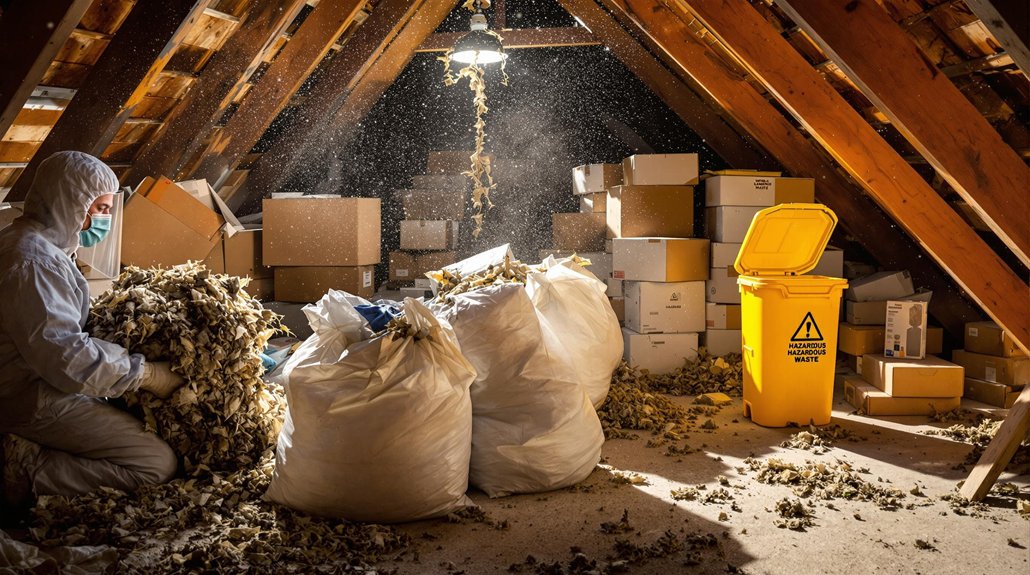
Properly disposing of waste is essential in the aftermath of a rodent infestation. Rodent waste, including droppings and urine, can pose health risks if not handled correctly. Begin by wearing protective gear, such as gloves, masks, and goggles, to minimize exposure. Gather all waste materials in sturdy, sealed bags to prevent contamination. For waste disposal, check local regulations to verify compliance; some areas may have specific guidelines for hazardous materials. Dispose of the bags in an outdoor trash bin that is securely closed. After removing the waste, clean the area thoroughly with a disinfectant to eliminate any remaining bacteria. Proper waste disposal not only creates a safer environment but also helps prevent future infestations.
Monitor for Recurrences
Although the immediate cleanup may seem complete, ongoing vigilance is essential to prevent a recurrence of rodent infestations. Understanding rodent behavior and implementing consistent monitoring practices can help safeguard your attic. Here are four effective strategies:
- Set up monitoring traps to catch any new arrivals quickly.
- Inspect entry points regularly to identify and seal any potential openings.
- Maintain cleanliness in the attic by storing items in sealed containers, reducing nesting opportunities.
- Observe signs of rodent activity, such as droppings or gnaw marks, and take action immediately.
Frequently Asked Questions
How Can I Tell if Rodents Are Still Present?
To determine if rodents are still present, look for rodent signs such as droppings, gnaw marks, and nests. Additionally, infestation indicators like unusual noises or tracks can confirm ongoing activity in the area.
What Types of Rodents Commonly Infest Attics?
Ah, the attic, a luxurious penthouse for rodent royalty! Common invaders include house mice and roof rats. Effective pest control involves identifying these mouse species to guarantee a thorough strategy for eradication and prevention.
Are There Natural Repellents for Rodents?
Natural repellents for rodents include essential oils such as peppermint and eucalyptus, which can deter these pests. Additionally, ultrasonic repellents emit high-frequency sounds that are unpleasant for rodents, offering a non-toxic alternative for prevention.
How Long Does Rodent Infestation Cleanup Take?
Approximately 30% of homes experience rodent infestations annually. The cleanup duration varies greatly, often taking one to three days depending on infestation severity, required disinfection, and necessary repairs to restore a safe environment for occupants.
Can I Hire Professionals for Attic Rodent Cleanup?
Yes, you can hire professional services for attic rodent cleanup. These experts guarantee thorough sanitation and safety. Cleanup costs vary based on the extent of damage and necessary repairs, but investing in professionals can prevent future infestations.
